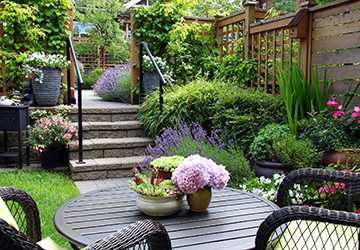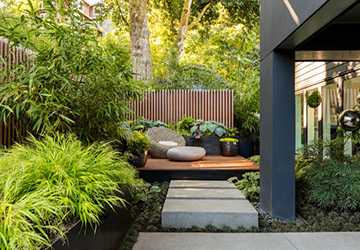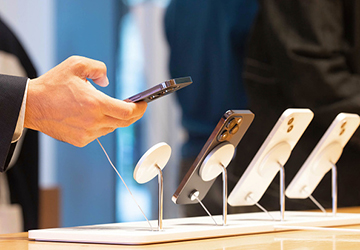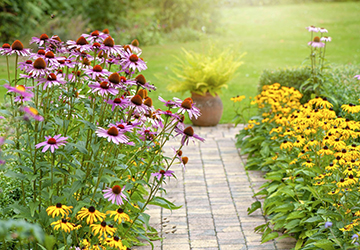Sustainability is the buzzword in every field, and garden design is no exception. With rising environmental concerns and an increased awareness about our ecological footprint, garden enthusiasts and landscapers are turning towards sustainable methods. The modern garden trends are all about merging beauty with responsibility. This article sheds light on the latest trends in sustainable landscape designs and the benefits of eco-friendly gardening.
Native Plant Landscaping
One of the primary modern garden trends is the use of native plants. These plants have evolved in the region over thousands of years, making them more resilient to local pests, diseases, and climatic conditions.
● Benefits: Reduced water usage, decreased pesticide dependence, and fostering local biodiversity.
● Eco-friendly gardening tip: Research local nurseries specializing in native plants or join a community gardening group for resources.

Edible Gardens
Modern households are increasingly turning to their gardens for organic produce. From herbs to vegetables and fruit trees, parks are getting deliciously diverse.
● Benefits: Fresh, pesticide-free produce, reduced carbon footprint from transporting goods, and a deeper connection to our food.
● Sustainable landscape design tip: Use companion planting methods to deter pests naturally.
Water-Saving Techniques
With water becoming a scarce resource, modern garden trends emphasize water conservation.
● Rainwater Harvesting: Collecting rainwater for garden use.
● Drip Irrigation: Using systems that deliver water directly to plant roots, reducing wastage.
● Mulching: This not only conserves moisture but also prevents weed growth.
● Eco-friendly gardening tip: Group plants with similar water needs together to optimize watering routines.
Sustainable Garden Materials
Eco-friendly gardening is not just about plants but also the materials used.
● Recycled Materials: Use reclaimed wood, bricks, or stones for garden beds or pathways.
● Local Materials: Sourcing materials locally reduces transportation emissions.
● Sustainable landscape design tip: Avoid using plastic. Opt for natural or recycled materials for plant pots and garden accessories.
Pollinator Gardens
With the alarming decline in pollinator populations, gardens that attract bees, butterflies, and birds are a significant modern garden trend.
● Benefits: Increased garden yield, especially for edible gardens, and contribution to conserving vital pollinator species.
● Eco-friendly gardening tip: Avoid using chemical pesticides and herbicides, which can harm pollinators.
Natural Pest Control
Instead of chemical pesticides, sustainable landscape designs incorporate plants and techniques that naturally deter pests.
● Benefits: Reduction in harmful chemical usage, safer produce, and maintenance of a balanced garden ecosystem.
● Eco-friendly gardening tip: Introduce plants like marigolds or lavender, known to repel certain pests.
Green Roofs and Walls
Urban areas, where space is a constraint, see a rise in vertical sustainable landscape designs.
● Benefits: Improved air quality, additional building insulation, and creation of urban green spaces.
● Modern garden trend tip: Ensure proper structural support and drainage systems before installing green roofs or walls.
Soil Health and Composting
At the heart of any eco-friendly gardening practice is soil health.
● Composting: Turning kitchen scraps into rich compost reduces waste and nourishes the soil.
● Natural Fertilizers: Using seaweed, manure, or worm castings ensures plants get nutrients without the harmful side effects of chemicals.
Minimalist Garden Designs
Modern garden trends are leaning towards simplicity. A minimalistic approach means less water, less maintenance, and a focus on a few standout plants or features.
● Benefits: Reduced resource usage and a calm, serene garden space.
● Eco-friendly gardening tip: Opt for perennial plants that require less care and return year after year.
Incorporating Technology
Surprisingly, technology and sustainable landscape designs can go hand in hand.
● Smart Watering Systems: Systems that detect moisture levels and water plants only when necessary.
● Solar Lighting: Use solar-powered lights to illuminate your garden without consuming electricity.
● Eco-friendly gardening tip: Invest in apps or software that offer advice on plant care, watering schedules, and seasonal tasks.
Multi-purpose Plants
Why grow a plant for a single purpose when it can serve multiple functions?
● Edible & Ornamental: Plants like blueberries can beautify a garden and provide fruit.
● Medicinal Plants: Herbs such as chamomile or mint can be healing and a delightful addition to the garden.
● Modern garden trend tip: Research plants that fit your local climate and can serve dual purposes.
Eco-Friendly Lawn Alternatives
Traditional lawns can be water and resource-intensive. Modern garden trends suggest alternatives:
● Ground Covers: Plants like creeping thyme or clover can replace grass, reducing the need for mowing or frequent watering.
● Ornamental Grasses: They add texture, movement, and beauty without the high maintenance of a conventional lawn.
● Eco-friendly gardening tip: Opt for drought-resistant grass varieties if you can't give up the green.

Wildlife-Friendly Spaces
Creating habitats for wildlife is becoming a central theme in modern garden trends. Gardeners look beyond plants to consider the animals and insects that might share their space.
● Birdhouses and Feeders: Installing these can attract various bird species, enhancing the garden's vitality and providing natural pest control.
● Water Features: A simple bird bath or a pond can invite birds and beneficial insects and amphibians.
● Sustainable landscape design tip: Plant berry-producing shrubs or seed-bearing plants. They serve as natural food sources for wildlife.
Zero-Waste Garden Zones
In alignment with the global zero-waste movement, modern garden trends focus on producing less waste in our garden activities.
● Compostable Pots: Using pots made from natural materials that can decompose, reducing plastic use.
● Seed Swaps: Organizing community seed exchanges to reduce the packaging waste of buying plants.
● Eco-friendly gardening tip: Practice grasscycling – leaving grass clippings on the lawn after mowing, providing natural fertilizer.
Digital Garden Planning
The digital age meets sustainable landscape designs through advanced planning tools and apps.
● Virtual Layouts: Using apps to pre-design garden layouts, ensuring optimal plant placement and resource utilization.
● Digital Plant Diaries: Using mobile applications to track plant growth, watering schedules, and fertilizing needs.
● Modern garden trend tip: Use augmented reality (AR) gardening apps to visualize certain plants' appearance in your space before purchasing.
Conclusion
The shift towards sustainable landscape designs and eco-friendly gardening isn't just a trend; it's a necessary evolution in response to global environmental changes. These modern garden trends aim to create harmonious spaces that benefit individuals and the broader ecosystem. By adopting these practices, gardeners and landscape designers can ensure a greener, more sustainable future.


